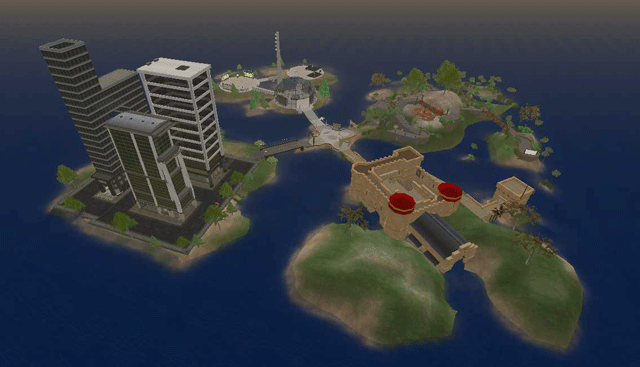
Introduction: Why Choose a Second Life?
“I’ve interviewed strippers and Catholic priests, combat veterans and peace activists, socialist utopians and midget warmongers. I’ve profiled entrepreneurs who own whole continents and earn six figure incomes from the buying and selling of virtual land, and a homeless hacker who built a virtual mansion while squatting in an abandoned building.
Other places I’ve conducted interviews: from the observation deck of a space station; from the virtual campaign headquarters for Senator John F. Kerry; on the soundstage of a film studio lot; sitting on a giant leaf at the edge of an Elven village; in a Wild West saloon; at a telecom control station; from a battleground draped on either side with Confederate flags and anti–Bush posters; in a hospital ward where disembodied voices whisper “death,” and the floor suddenly opens into the sky. At an online Burning Man and an in–world Oz; in the office of a private detective who sting unfaithful lovers in honey trap operations; at weddings, funerals, and heart–breaking memorials.
[N]one of these events or persons really exist, except as data bits in a San Francisco server farm…” (Au, 2005, p. 3).
As one of the first “in-world journalists” in Second Life, Wagner James Au saw all these things and more in his travels through this immense online virtual world. The space, online since 2003, was developed by Linden Research, Inc., commonly referred to as Linden Lab; the site itself is “a 3-D virtual world created by its Residents [that has] has grown explosively and today is inhabited by millions of Residents from around the globe” (“What is Second Life”).
Over the past few years, many individuals have signed up for their own free Second Life accounts; once they have passed through Orientation Island, the first stop for all new avatars, they have moved on to interacting with others, building items, and customizing their avatars.

Second Life's "Orientation Island." Image courtesy of greg_r.bm on Flickr.
Second Life has grown in popularity among educators because of their interest in the possible pedagogical uses of video and computer games, including their potential ability to strengthen students’ critical media literacies. Now institutions like Ball State University and The Ohio State University have firmly entrenched presences in Second Life (Jennings & Collins, 2008). What Second Life and sites similar to it can offer rhetoric and composition instructors is a space ripe for active student learning, learning that also asks students to grapple with "big picture" issues like subjectivity and materiality in a participatory fashion. Through engaged student learning, games in the writing classroom can move us closer to the kind of multimodal literacies that scholars like Kathleen Yancey (2004), Lester Faigley (2006), Cynthia L. Selfe and Gail E. Hawisher (2007) and others have called for rhetoric and composition instructors to incorporate into their pedagogies.

